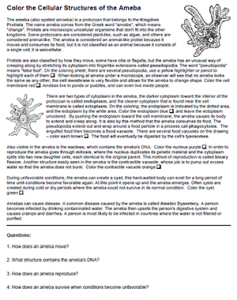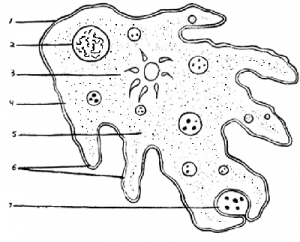
This worksheet describes the structures of the unicellular protist known as the ameba. Though NGSS standards do not require units on protozoans, this can still be a useful exercise for examining how structure relates to function and how single-celled organisms move, consume food, and reproduce.
What is the amoeba?
An amoeba is a type of cell or unicellular organism that can alter its shape by extending and retracting pseudopods. Amoebas are eukaryotes, which means their DNA is packaged into a central cellular compartment called the nucleus.
They also contain specialized structures called organelles, which perform a range of cellular functions including energy production and protein transport
Students read a passage that describes cell parts such as the nucleus, contractile vacuole, endoplasm, and pseudopodia and then color these structures on a drawing of the ameba. Worksheet questions can be answered by reading the passage carefully.

Grade Level: 7-10
Time Required: 20-30 minutes
CCSS.ELA-LITERACY.RST.9-10.4 Determine the meaning of symbols, key terms, and other domain-specific words and phrases as they are used in a specific scientific or technical context relevant to grades 9-10 texts and topics.
HS-LS1-2 Develop and use a model to illustrate the hierarchical organization of interacting systems that provide specific functions within multicellular organisms

